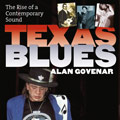Lightnin' Hopkins: His Life and Blues
by Alan Govenar
About
Details:352 pages, Hardcover, ISBN: 978-1556529627
Publisher: Chicago Review Press, May 2010
Format:
9.1 x 6.1 x 1.2 in.
Born in 1912 to a poor sharecropping family in the cotton country between Dallas and Houston, Hopkins left home when he was only eight years old with a guitar his brother had given him. He made his living however he could, sticking to the open road, playing the blues, and taking odd jobs when money was short. This biography delves into Hopkins’s early years, exploring the myths surrounding his meetings with Blind Lemon Jefferson and Texas Alexander, his time on a chain gang, his relationships with women, and his lifelong appetite for gambling and drinking.
Hopkins didn’t begin recording until 1946, when he was dubbed “Lightnin’” during his first session, and he soon joined Muddy Waters and John Lee Hooker on the national R & B charts. But by the time he was “rediscovered” by Mack McCormick and Sam Charters in 1959, his popularity had begun to wane. A second career emerged--now Lightnin’ was pitched to white audiences, not black ones, and he became immensely successful, singing about his country roots and injustices that informed the civil rights era with a searing emotive power.
More than a decade in the making, this biography is based on scores of interviews with Lightnin’s lover, friends, producers, accompanists, managers, and fans.
Interview with Alan Govenar about Lightnin' Hopkins
Download the mp3 from Alan's interview on Dallas' KERA program Think.
Reviews
From "Booklist"
In only the second biographical book on seminal blues guitarist-singer Hopkins (see Sarah Ann West, Deep Down Hard Blues, 1995), Govenar traces Hopkins’ long, twisting route to worldwide fame. Leaving home when still a child, Hopkins spent most of his life pursuing the sex-and-drinks-and-blues lifestyle that preceded the sex-and-drugs-and-rock-’n’-roll model, at least in the popular imagination. Apparently dubbed Lightnin’ at his 1946 first recording session, the moniker wasn’t, as oft-rumored, a tribute to his guitar stylings but made to go with session-mate Wilson Smith being called Thunder. Govenar finds that much else of what fans think they know about Hopkins doesn’t stand up to investigation, yet in pursuit of the truth via extensive interviews with family and friends, he turns up many nuggets as satisfying as the dispelled myths and inconsistencies. His detailed examination of how the delightfully cantankerous Hopkins rode the folk music craze of the early 1960s to rediscovery and a second, probably more remunerative recording career should be a cornerstone of blues-covering pop-music collections. --Mike Tribby
From "Library Journal"
In this first full-length biography of the prolific and influential blues icon Sam “Lightnin’” Hopkins, Texas blues expert Govenar, author of the encyclopedic Texas Blues: Rise of a Contemporary Sound, presents important new research and employs neglected primary sources to offer an accessible critical analysis of Hopkins’s artistic achievement buttressed by generous quotations from his lyrics. Hopkins, a guarded individual who lived most of his life in Houston’s Third Ward, left a murky trail that Govenar follows with an admirable skepticism. The incarcerations of Hopkins’s youth remain a mystery, with his scarred ankles the only concrete evidence of his chain-gang experience. His better-documented later years are highlighted by his rediscovery (a misnomer, as he recorded from the late 1940s onward without break) by blues enthusiasts whose treatment of him ranged from idolatrous to shameful. Verdict This first biography of an important figure in blues history is an essential purchase for anyone interested in American popular music or African American culture.—John Frank, Los Angeles P.L.
From "Dallas Morning News"
...Govenar persists through this maze and succeeds in offering the most compelling and coherent account of this blues star yet published. This author, who has written extensively on Texas blues, is the perfect person to unravel the tangled threads here. He has tracked down Hopkins' boyhood buddies, family members, record producers and others to fill in the blanks and flesh out a fascinating story.Govenar clearly is inspired by Hopkins' legacy and is a sympathetic biographer. He's also a skeptical one, as is necessary for anyone trying to unlock the mystery of Lightnin' Hopkins. Hopkins worked hard to craft his image. Everything from the flashy clothing to the oversize sunglasses were part of the intended effect. Govenar takes nothing at face value and, to his credit, never gets caught up in hero worship.
Many gaps remain in our understanding of Hopkins. Much may never be explained, from the reasons for his incarcerations to the stories behind many songs. Yet Govenar has given us a more complete picture than we have ever had before and, for the time being, his book is the definitive guide to this iconic blues artist.





